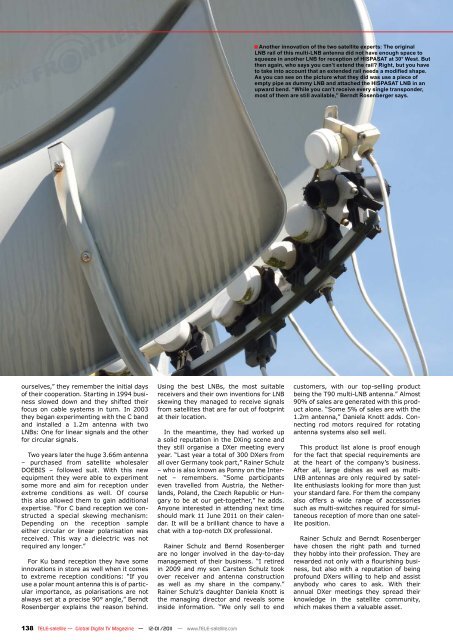TELE-satellite International Magazine
TELE-satellite International Magazine
TELE-satellite International Magazine
Create successful ePaper yourself
Turn your PDF publications into a flip-book with our unique Google optimized e-Paper software.
ourselves,” they remember the initial days<br />
of their cooperation. Starting in 1994 business<br />
slowed down and they shifted their<br />
focus on cable systems in turn. In 2003<br />
they began experimenting with the C band<br />
and installed a 1.2m antenna with two<br />
LNBs: One for linear signals and the other<br />
for circular signals.<br />
Two years later the huge 3.66m antenna<br />
– purchased from <strong>satellite</strong> wholesaler<br />
DOEBIS – followed suit. With this new<br />
equipment they were able to experiment<br />
some more and aim for reception under<br />
extreme conditions as well. Of course<br />
this also allowed them to gain additional<br />
expertise. “For C band reception we constructed<br />
a special skewing mechanism:<br />
Depending on the reception sample<br />
either circular or linear polarisation was<br />
received. This way a dielectric was not<br />
required any longer.”<br />
For Ku band reception they have some<br />
innovations in store as well when it comes<br />
to extreme reception conditions: “If you<br />
use a polar mount antenna this is of particular<br />
importance, as polarisations are not<br />
always set at a precise 90° angle,” Berndt<br />
Rosenberger explains the reason behind.<br />
138 <strong>TELE</strong>-<strong>satellite</strong> — Global Digital TV <strong>Magazine</strong> — 12-01/2011 — www.<strong>TELE</strong>-<strong>satellite</strong>.com<br />
■<br />
Using the best LNBs, the most suitable<br />
receivers and their own inventions for LNB<br />
skewing they managed to receive signals<br />
from <strong>satellite</strong>s that are far out of footprint<br />
at their location.<br />
In the meantime, they had worked up<br />
a solid reputation in the DXing scene and<br />
they still organise a DXer meeting every<br />
year. “Last year a total of 300 DXers from<br />
all over Germany took part,” Rainer Schulz<br />
– who is also known as Ponny on the Internet<br />
– remembers. “Some participants<br />
even travelled from Austria, the Netherlands,<br />
Poland, the Czech Republic or Hungary<br />
to be at our get-together,” he adds.<br />
Anyone interested in attending next time<br />
should mark 11 June 2011 on their calendar.<br />
It will be a brilliant chance to have a<br />
chat with a top-notch DX professional.<br />
Rainer Schulz and Bernd Rosenberger<br />
are no longer involved in the day-to-day<br />
management of their business. “I retired<br />
in 2009 and my son Carsten Schulz took<br />
over receiver and antenna construction<br />
as well as my share in the company.”<br />
Rainer Schulz’s daughter Daniela Knott is<br />
the managing director and reveals some<br />
inside information. “We only sell to end<br />
Another innovation of the two <strong>satellite</strong> experts: The original<br />
LNB rail of this multi-LNB antenna did not have enough space to<br />
squeeze in another LNB for reception of HISPASAT at 30° West. But<br />
then again, who says you can’t extend the rail? Right, but you have<br />
to take into account that an extended rail needs a modified shape.<br />
As you can see on the picture what they did was use a piece of<br />
empty pipe as dummy LNB and attached the HISPASAT LNB in an<br />
upward bend. “While you can’t receive every single transponder,<br />
most of them are still available,” Berndt Rosenberger says.<br />
customers, with our top-selling product<br />
being the T90 multi-LNB antenna.” Almost<br />
90% of sales are generated with this product<br />
alone. “Some 5% of sales are with the<br />
1.2m antenna,” Daniela Knott adds. Connecting<br />
rod motors required for rotating<br />
antenna systems also sell well.<br />
This product list alone is proof enough<br />
for the fact that special requirements are<br />
at the heart of the company’s business.<br />
After all, large dishes as well as multi-<br />
LNB antennas are only required by <strong>satellite</strong><br />
enthusiasts looking for more than just<br />
your standard fare. For them the company<br />
also offers a wide range of accessories<br />
such as multi-switches required for simultaneous<br />
reception of more than one <strong>satellite</strong><br />
position.<br />
Rainer Schulz and Berndt Rosenberger<br />
have chosen the right path and turned<br />
they hobby into their profession. They are<br />
rewarded not only with a flourishing business,<br />
but also with a reputation of being<br />
profound DXers willing to help and assist<br />
anybody who cares to ask. With their<br />
annual DXer meetings they spread their<br />
knowledge in the <strong>satellite</strong> community,<br />
which makes them a valuable asset.

















